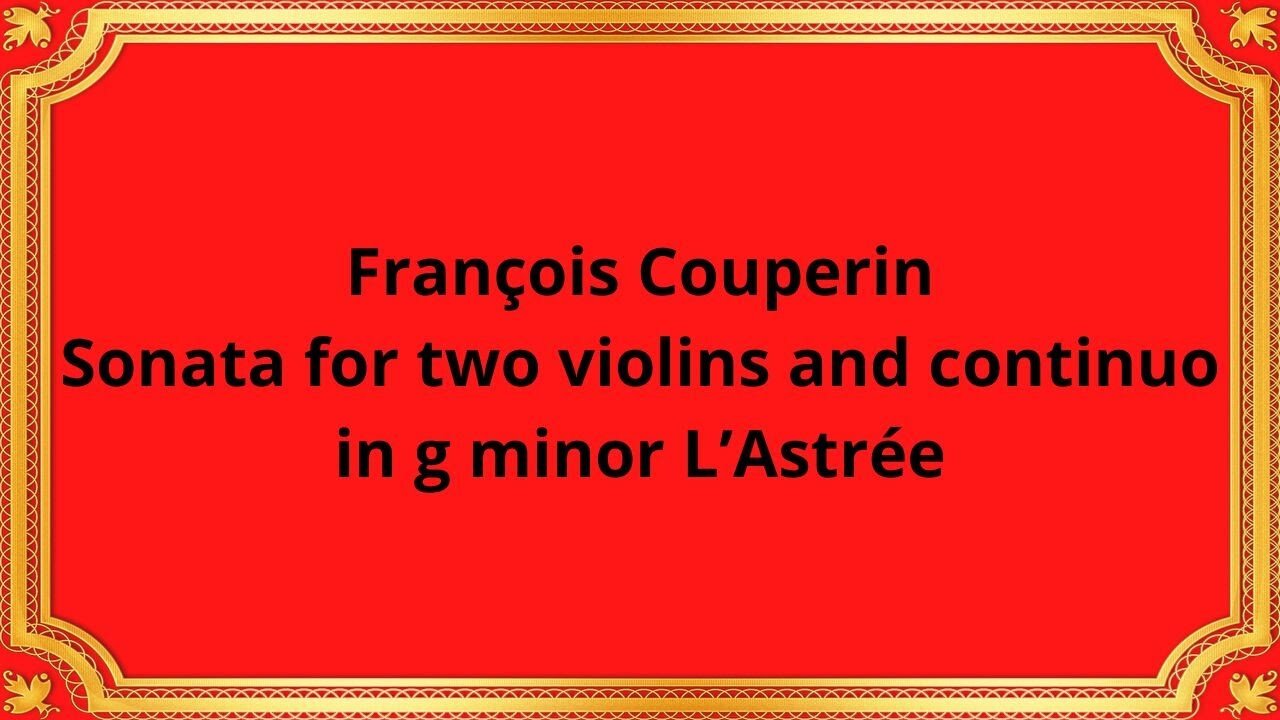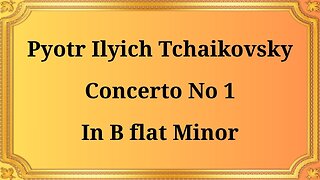Premium Only Content

François Couperin Sonata for two violins and continuo in g minor L’Astrée
#classicalmusic #FrançoisCouperin #Sonata #twoviolins #continuo #gminor #LAstrée #Baroquemusic #chambermusic #violinrepertoire #Frenchcomposers #Couperinsworks #historicalperformancepractice
Publication date 1949
Ars Rediviva
Dominique Blot (violin)
Edmee Ortmans-Bach (violin)
Jacqueline Alliaume ('cello)
Claude Crussard (harpsichord / director)
François Couperin, a prominent French composer of the Baroque era, left a significant impact on classical music through his rich and expressive compositions. Among his notable works is the Sonata for Two Violins and Continuo in G Minor, L'Astrée.
François Couperin, born in 1668, was a highly esteemed French composer, harpsichordist, and organist. He was a prominent figure in the French musical scene, known for his contribution to Baroque music. Couperin's compositions were characterized by their elegance, refined ornamentation, and innovative use of harmony.
The Sonata for Two Violins and Continuo in G Minor, L'Astrée, is a chamber music composition by François Couperin. It is believed to have been composed in the early 18th century. This sonata showcases Couperin's mastery of the chamber music genre and his ability to create captivating dialogues between two violins accompanied by a continuo instrument, typically a harpsichord or a cello.
The Sonata for Two Violins and Continuo in G Minor, L'Astrée, is structured in multiple movements, each offering a distinct musical character. Couperin's composition typically consists of four movements: Allemande, Sarabande, Gavotte, and Gigue. Each movement presents different rhythms, melodic patterns, and harmonic progressions, contributing to the overall narrative of the sonata.
The Allemande movement, often characterized by its moderate tempo and dance-like quality, sets the tone for the piece. The Sarabande follows, offering a slower and more introspective mood, showcasing Couperin's ability to create expressive and lyrical melodies. The Gavotte injects a sense of liveliness and elegance into the composition, while the Gigue, a fast-paced movement, brings the sonata to a vibrant and exhilarating conclusion.
The Sonata for Two Violins and Continuo in G Minor, L'Astrée, holds significant importance in the chamber music repertoire. Couperin's composition showcases his ability to create intricate and nuanced musical dialogues between the two violins, accompanied by the continuo instrument. The sonata exemplifies his skillful use of counterpoint, harmonies, and ornamentation, which were characteristic of the French Baroque style.
The enduring legacy of Couperin's Sonata for Two Violins and Continuo lies in its ability to captivate audiences with its refined melodies, expressive harmonies, and intricate musical interplay. Its performances by chamber ensembles and violinists around the world continue to highlight Couperin's compositional genius and his significant contribution to the classical music canon.
Conclusion:
François Couperin's Sonata for Two Violins and Continuo in G Minor, L'Astrée, stands as a testament to the composer's skillful craftsmanship and his impact on the chamber music genre. Through its engaging melodies, refined harmonies, and intricate interplay between the two violins and the continuo, the sonata showcases Couperin's ability to create captivating and expressive music in the Baroque style. As we explore the depths of this remarkable composition, we gain a deeper appreciation for Couperin's legacy and his lasting influence on the world of classical music.
You have the opportunity to support the channel:
https://destream.net/live/RadSiarAl/donate
https://www.buymeacoffee.com/6355radsiaral
-
 31:06
31:06
Classical music_Music Inspiration
3 days agoPyotr Ilyich Tchaikovsky Piano Concerto No. 1 in B-flat minor
351 -
 2:12:28
2:12:28
Badlands Media
15 hours agoBaseless Conspiracies Ep. 144: NATO Narratives, Media Meltdowns & a Brightcore Boost with Kim Bright
109K16 -
 2:02:11
2:02:11
Inverted World Live
10 hours agoGiant Underground Blob Moving Toward NY | Ep. 85
51.8K20 -
 2:46:21
2:46:21
TimcastIRL
9 hours agoTexas GOP Greenlights ARREST WARRANTS For Dems Who FLED State | Timcast IRL
248K92 -
 3:16:50
3:16:50
Laura Loomer
9 hours agoEP137: EXPOSED: How Tucker Carlson Became Hunter Biden's Wingman
71.7K82 -
 4:22:34
4:22:34
Akademiks
8 hours agoNicki Minaj vs Dez Bryant. Trump Calls out Charlamagne. Diddy Denied Bail Again! ICEMAN soon?
57.2K3 -
 3:16:28
3:16:28
Nerdrotic
10 hours ago $9.32 earnedNerdrotic at Night 504
82.9K3 -
 8:20:30
8:20:30
Dr Disrespect
18 hours ago🔴LIVE - DR DISRESPECT - WARZONE - RANDOMLY GENERATED LOADOUTS EVENT
232K9 -
 1:36:07
1:36:07
Glenn Greenwald
12 hours agoTrump Admin Unleashes More Policies That Prioritize Israel Over American Citizens; The Smear Campaign Against Gaza Aid Whistleblower with Journalist Mel Witte | SYSTEM UPDATE #497
152K195 -
 58:14
58:14
MattMorseTV
11 hours ago $14.81 earned🔴Hakeem just lost EVERYTHING.🔴
88.2K63